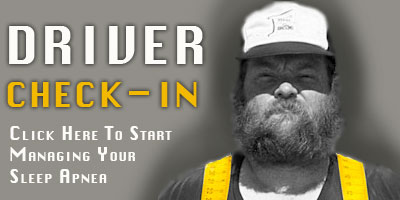Ways to address the condition that adds to Fatigue
In the transportation industry, many risk managers and commercial drivers have to deal with the problem of sleep apnea, a condition that is directly related to daytime drowsiness, as they look for ideas to improve road safety. According to the Federal Motor Carrier Safety Administration (FMSCA) estimates that up to 26% of licensed commercial drivers have some level of sleep apnea. Per a FMSCA study, 17% of commercial drivers have mild sleep apnea, 5% have moderate, and 4% have severe prevalence of sleep apnea.
It has been shown in several studies that sleep apnea can directly impact driving performance by increasing fatigue therefore the direct relation of increasing the risk of crashes. The trucking industry is well aware of the awareness and prevalence of sleep apnea among drivers, however there are ways that the condition can be diagnosed, treated, and monitored.
Obstructive Sleep Apnea (OSA) is when the airway in the back of the throat is constricted due to the muscular relaxation when sleeping thus causing interruptions of a person breathing lasting several seconds at a time. Loud snoring is followed as the person gasps for air and resulting in a night of no restful sleep. Individuals considered at risk for sleep apnea are those with a body mass index of 35 or greater and a neck size of 17 inches or more for men and 16 inches for women. Many medical experts have stated that these types of individuals quite often suffer from other medical conditions such as diabetes and heart problems related to obesity.
Researchers say that there are a countless number of people that are not aware that they even have sleep apnea. Sleep apnea quite often contributes to daytime sleepiness, which impacts reflexes and motor skills. Even if the vast numbers of commercial drivers have some type of sleep apnea, many drivers are not willing to talk about it or admit that they may have the medical condition. There needs to be a way to educate the drivers about sleepiness and the dangers it can cause.
Currently the Federal Motor Carrier Safety Administration (FMSCA) has given guidelines on sleep apnea to the DOT Examiners for medical examination report on commercial driver’s physicals. It states the following for Respiratory Dysfunction 391.41(b)(5): A person is physically qualified to drive a commercial motor vehicle if that person:
Has no established medical history or clinical diagnosis of a respiratory dysfunction likely to interfere with the ability to control and drive a commercial motor vehicle safely.
Since a driver must be alert at all times, any change in his or her mental state is in direct conflict with highway safety. Even the slightest impairment in respiratory function under emergency conditions (when greater oxygen supply is necessary for performance) may be detrimental to safe driving.
There are many conditions that interfere with oxygen exchange and may result in incapacitation, including emphysema, chronic asthma, carcinoma, tuberculosis, chronic bronchitis and sleep apnea. If the medical examiner detects a respiratory dysfunction, that in any way is likely to interfere with the driver’s ability to safely control and drive a commercial motor vehicle, the driver must be referred to a specialist for further evaluation and therapy.
The guidelines are currently under review but are not yet regulation. Many DOT examiners and trucking companies are taking the guidelines seriously and have implemented screening policies. The National Registry for Medical Examiners will be keying in on sleep apnea and only physicians that are in National Registry for Medical Examiners will be allowed to conduct DOT exams.

